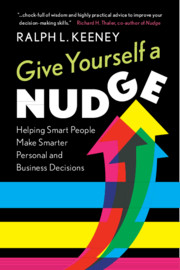Book contents
- Reviews
- Give Yourself a Nudge
- Give Yourself a Nudge
- Copyright page
- Dedication
- Contents
- Preface
- Acknowledgments
- 1 Nudge Yourself to Make Better Decisions
- 2 Your Decisions and Your Life
- 3 Making Value-Focused Decisions
- 4 Defining Your Decision
- 5 Identifying Your Values
- 6 Creating Alternatives
- 7 Identifying Decision Opportunities
- 8 Obtaining Authorization to Select Alternatives Controlled by Others
- 9 Becoming a Value-Focused Decision-Maker
- 10 Enhancing the Quality of Your Life
- 11 Useful Perspectives on Decision-Making
- Appendix Evaluating Alternatives and Making a Decision
- Notes
- Index
4 - Defining Your Decision
Published online by Cambridge University Press: 17 April 2020
- Reviews
- Give Yourself a Nudge
- Give Yourself a Nudge
- Copyright page
- Dedication
- Contents
- Preface
- Acknowledgments
- 1 Nudge Yourself to Make Better Decisions
- 2 Your Decisions and Your Life
- 3 Making Value-Focused Decisions
- 4 Defining Your Decision
- 5 Identifying Your Values
- 6 Creating Alternatives
- 7 Identifying Decision Opportunities
- 8 Obtaining Authorization to Select Alternatives Controlled by Others
- 9 Becoming a Value-Focused Decision-Maker
- 10 Enhancing the Quality of Your Life
- 11 Useful Perspectives on Decision-Making
- Appendix Evaluating Alternatives and Making a Decision
- Notes
- Index
Summary
Before acting to solve some recognized decision problem, it is important to think about which immediate decision you should face. Once you recognize a decision, you want to develop a clear and concise statement of this decision. You have an important choice—in fact, a decision itself–about the decision statement that you choose to describe the decision that you want to face. Your decision statement is the starting point for nudging your thinking about sets of appropriate values and alternatives to create the decision frame for your decision. Begin any decision statement with the word “decide,” typically followed by “which,” “what,” “when,” “whether,” “how,” or “if.” Decision statements are often narrow and end up addressing only part of the real decision. You want any mention of values in your decision statement to be broad. Before accepting any decision statement posed for you by someone else, you should carefully consider whether you want to address that decision.
Keywords
- Type
- Chapter
- Information
- Give Yourself a NudgeHelping Smart People Make Smarter Personal and Business Decisions, pp. 36 - 48Publisher: Cambridge University PressPrint publication year: 2020



